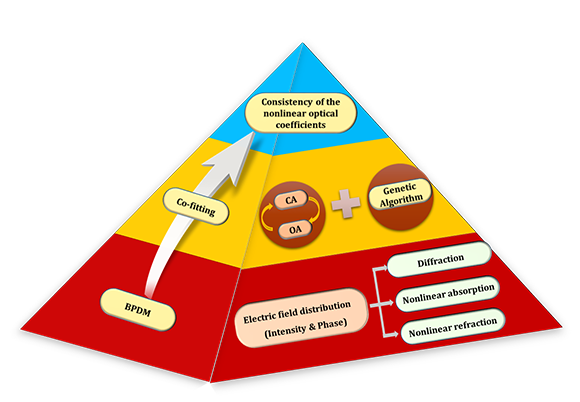Optical nonlinear effects such as nonlinear refraction, multi-photon absorption and saturation absorption have been widely exploited in applications of fluorescence spectroscopy, optical pulse metrology, pulse shaping, mode-locked lasers, optical limiting, and all-optical switches. The characterization of nonlinear optical coefficients is a very important task for the evaluation and selection of suitable optical materials.
Since its invention in 1989, the z-scan technique has been widely used in investigation of nonlinear optical materials, with nonlinear optical coefficients obtained by fitting the experimental data with the Sheik-Bahae's model. However, in many z-scan measurements using femtosecond pulsed lasers, poor fitting has been quite commonly encountered in accompany with large deviation between theoretical curves and experimental data. Furthermore, there is a lack of consistency among the nonlinear parameters extracted from the same substance in different reports. Due to ignorance of the prerequisite for the theoretical model, the fitting results are severely affected by experimental conditions. According to common sense in physics, nonlinear optical coefficients are intrinsic properties of materials and must be independent of experimental conditions.
Recently, the research group led by Prof. Ting Mei from the Key Laboratory of Space Applied Physics and Chemistry, Ministry of Education, and Shaanxi Key Laboratory of Optical Information Technology, Northwestern Polytechnical University studied the issue of the consistency of the nonlinear optical coefficients in z-scan measurement. A new model was developed based on Gaussian beams propagation through a nonlinear medium and Fresnel-Kirchoff diffraction integration. Highly consistent nonlinear optical coefficients were obtained for samples with different thicknesses under different radiation intensities. The research results are published in Chinese Optics Letters, Vol. 18, Issue 7, 2020 (Shijia Hua, Kang Du, Heng Wang, et al. Affirming nonlinear optical coefficient constancy from z-scan measurement[J]. Chinese Optics Letters, 2020, 18(7): 071903).
The beam propagation diffraction model (BPDM) proposed in this work solves the wave equation through the propagation of a Gaussian beam in a nonlinear medium, and the Fresnel-Kirchoff diffraction integral is utilized to further obtain the intensity distribution in the aperture plane. Nonlinear absorption, nonlinear refraction and diffraction during propagation in the sample are taken into consideration. Without limitation of the thin sample condition and the laser intensity, the z-scan experiment can be conducted at high nonlinear signal level to guarantee measurement accuracy. In addition, numerical calculation combined with the Genetic Algorithm (GA) allows to co-fit the experimental data of open-aperture (OA) and closed-aperture (CA) cases and obtain the nonlinear refractive index and nonlinear absorption coefficient simultaneously with further improved fitting accuracy. It is noticeable that, the determined third-order nonlinear parameters of carbon disulfide (β = 5.0 × 10-13 m W-1 and γ = 2.0 × 10-19 m2 W-1) maintain constancy regardless of variations in sample thickness and laser intensity, which clarifies the physical significance of optical parameters.
The beam propagation diffraction model developed in this work can be further exploited to obtain more accurate nonlinear coefficients of nonlinear optical media, as the z-scan measurement is allowed for high level of laser intensity and large sample thickness. The constancy of extracted parameters to the incident light intensity can be taken as a measure to the goodness of the z-scan measurement.

BPDM takes into account the nonlinear absorption, nonlinear refraction effects as well as the diffraction effect in propagation. Through numerical simulation calculation and genetic algorithm, the OA and CA experimental data are co-fitted to obtain nonlinear optical coefficients with constancy.


